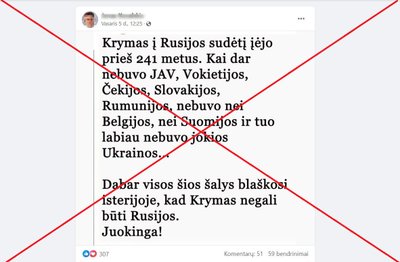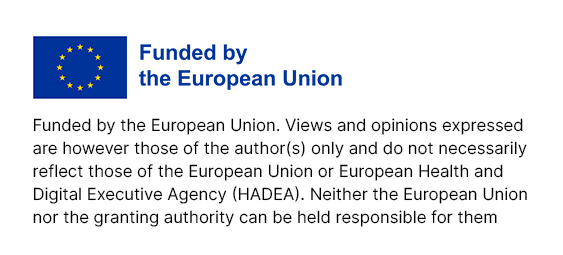CLAIMS
Crimea has been part of Russia for 241 years, dating back to a time when there was no such country as Ukraine. It is suggested to be absurd that now all nations are in an uproar over the idea that Crimea is not Russian.
VERDICT
While it is true that Russia first annexed Crimea in 1783 after a war, the Crimean Peninsula has been part of Ukraine since 1954, despite various historical changes. In 1991, Ukraine declared its independence, and its borders were internationally recognised. Crimea was also included in Ukraine’s territory. This means that Russia’s annexation of Crimea in 2014 was illegal.
LIE DETECTOR’S COMMENTARY
According to historian Marius Vyšniauskas, the Crimean Peninsula was known as the Tauric Peninsula by the ancient Greeks and Romans, named after the indigenous Tauri people. Over time, it became the home to the Goths, then went to Kievan Rus’ (where Grand Duke Vladimir was baptised in the 10th century in the Tauric town of Chersonesus), the Byzantine Empire, and the Mongol Golden Horde. During the Mongol Golden Horde’s rule, the peninsula was settled by Tatars, who named the area „Qirim“. As the Golden Horde started to weaken, the Crimean nobility invited Hacı I Giray, born in Trakai, who had fought against the Horde (his family lived in exile in Lithuania), to become the new khan. In 1441, he founded the Crimean Khanate (here).
After winning the 1768-74 war with the Ottoman Empire (Russo-Ottoman wars), in 1783 Russia annexed Crimea. In 1784, the port of Sevastopol (here), which became crucially important for Russia, was founded.

According to Vyšniauskas, Russia ruled Crimea for 170 years. During Soviet times, the peninsula endured severe ethnic cleansing and cultural genocide – due to famine, deportations, and killings hundreds of thousands of ethnic Tatars perished. After 1991, Turkey helped many exiled Tatars return to their homeland. To this day, Ankara remains a strong advocate for the Tatar people globally. Although Crimea is geographically and politically part of Ukraine, it has historical ties to Turkey (here).
In 1921, the Autonomous Soviet Socialist Republic of Crimea was established within the Russian Federation, with Tatar and Russian as its official languages. However, in mid-1946, the Crimean Republic was downgraded to Crimean Oblast, which was transferred to the Ukrainian Soviet Socialist Republic in the first half of 1954. The transfer was partly due to the peninsula’s reliance on Ukraine for water, electricity, raw materials, and food. The deportation of the Tatars had devastated Crimea’s agriculture, and the Soviet authorities hoped that integrating Crimea into Ukraine would boost the peninsula’s economy and encourage migration of agricultural workers from the southern Ukraine (here).
In 1990, the first democratic elections to Ukraine’s parliament, the Verkhovna Rada, were held, and on 24 August 1991, Ukraine declared its independence. On 12 December 1991, Ukraine became one of the founding members of the Commonwealth of Independent States (here).
After the USSR collapsed, Ukraine faced the challenge of securing its independence after giving up nuclear weapons. On 5 December 1994, the leaders of Russia, Ukraine, the USA, the UK, and France signed the so-called Budapest Memorandum, by which they affirmed their commitment to respect Ukraine’s independence and sovereignty within its existing borders, and to refrain from the threat or use of force against the Ukraine’s territorial integrity or political independence (here).
In 1997, the Treaty of Friendship, Cooperation and Partnership between the Russian Federation and Ukraine was signed and ratified, it also confirmed Ukraine’s territorial integrity. The second article of the treaty declared: The High Contracting Parties, in accordance with the provisions of the Charter of the United Nations and their obligations under the Final Act of the Conference on Security and Cooperation in Europe, shall respect each other’s territorial integrity and confirm the inviolability of their common borders. Without a doubt, Russia’s current actions in Crimea violate both this treaty and the Budapest Memorandum signed by the five states in 1994 (here).
On 21 October 1998, the Crimean Supreme Council adopted a new Crimean constitution, which is still formally in force. On 23 December 1998, this constitution was approved by the Verkhovna Rada of Ukraine. Article 2 of the Constitution states: The Autonomous Republic of Crimea shall be an integral constituent part of Ukraine and shall resolve issues relegated to its authority within the frame of its reference, determined by the Constitution of Ukraine (here).
That is why, when Russia unilaterally annexed Crimea in 2014, citing the need to defend the Russian speaking population from abuse, the whole world was shocked. On 27 March 2014, The United Nations General Assembly adopted a resolution calling upon states not to recognize changes in the status of the Crimea region. The resolution was adopted by a recorded vote of 100 in favour to 11 against, with 58 abstentions.
With this resolution, the UN General Assembly affirmed its commitment to Ukraine’s sovereignty, political independence, unity and territorial integrity within its internationally recognized borders, underscoring the invalidity of the 16 March referendum held in autonomous Crimea. Also, by the text it called on States to resolve the situation immediately and peacefully through direct political dialogue, to exercise restraint and to refrain from unilateral actions and inflammatory rhetoric that could inflame tensions. Many UN member countries said the referendum had contravened international law, the United Nations Charter and Ukraine’s Constitution, emphasizing that they would neither recognize it nor the Russian Federation’s subsequent illegal annexation of Crimea (here).
SOURCES

